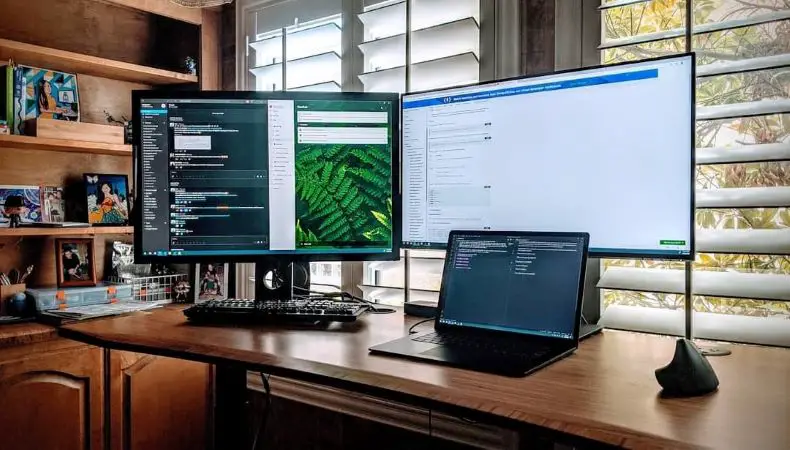More international workers than ever before are operating remotely in the post-COVID-19 era. This means the rigid daily commute and necessary on-site work are no longer required.
One thing about the state of modern work, though, has stayed the same: it’s critical to have a designated area where you can focus, work effectively, and be creative without interruptions.
However, many people have set up temporary home offices that will only last for a while in response to the pandemic. The physical setup of the workspace, or its ergonomics, is just as important as having the right tools, particularly when it comes to preventing repetitive strain injuries that an unsuitable setup can bring on.
A long-term home office should be a dedicated area of your house that is well-equipped for work. To establish an efficient, secure workspace for the long run, take as many of the following actions as possible.
Tips for setting up a home office with your laptop or PC

Here are the tips you need to take to ensure that your home workplace supports your work over the long haul without harming your health.
Read Also: How to choose the right laptop or PC for video editing in 2023
A designated area
For the vital need to separate work life from family life, you should ideally use a small room that can house a desk and computer equipment and whose door can be closed.
Of course, most people don’t have extra space, but many can turn a guest room into a space that serves as both a workplace and a guest room when guests are over. (If your space and budget allow, a Murphy bed is a superb way to do that.)
The same can be said for an enclosed porch, a sizable washing room (or drying room for Europeans), or even a garden shed.
Find a niche area as far away from the rest of the household’s — and theirs — path as possible. If you can’t get a dedicated space, you can isolate yourself from the rest of your existence.
Proper work height
A workstation or table at work height is necessary for your area. The standard in the business is 29 inches from the bottom of the work surface to the top. Short people benefit from a lower height, while tall people benefit from a more significant size.
Many tables and workstations can be raised or lowered by the feet. However, that industry norm is founded on handwriting, not using a keyboard and mouse.
Keyboard trays are typically an inch or two lower than desk or table height and pull out from below the work area because of this.
Get a keyboard and mouse tray if you have room for one (it must be broad enough for both!). In that case, think about lowering your workstation to tray height; if you also write on paper, get a writing surface (like a thin cutting board) for pen-and-paper work.
Your work surface is at the correct height if your forearms are parallel to the ground when you sit up straight, and your wrist is not bent up or down when you type or use a mouse.
The top surface of your wrist should be on the same plane as the top of your forearm, with your digits hanging slightly below the keyboard. Long-term wrist bending is a simple method to harm your wrists.
Get A Big Monitor and Monitor Raiser
Get a big monitor (or two) for your home workplace, just like at the company headquarters. Any big brand will have high-quality monitors, but Asus and Acer, 25 to 27-inch models, seem the best.
If possible, steer clear of the most affordable monitors, as their lower resolution and increased fuzziness can cause eyestrain after extended use.
There are many different display resolutions, but to get the desired higher sharpness, search for the following terms: 4K UHD, QHD, WQHD, or QWXGA.
Also, your monitor should be positioned so that when you sit upright and gaze straight ahead, your eyes will be between 25% and 30% below the top of the screen.
In doing so, you avoid hunching your back and hunching your shoulders, both of which are simple methods to injure yourself.
You’ll probably need a monitor riser to get the right height; I use two because it provides me with some helpful shelving. Although you might still require a riser, a display with adjustable height is a bonus.
To achieve the “top is 25% to 30% above eye level” goal, measure the desired monitor height from the work surface. This will help you determine the required rise between the monitor stand and the work surface.
Read Also: How to speed up your slow PC or laptop
A decent settee
Many poor seats can harm you if you use a computer for an extended time. For instance, dining and deck chairs are frequently too low and only sometimes promote the necessary upright position.
Get an adjustable professional office chair, such as an Aeron, if you can afford it so that you can customize it, but those usually cost $600 and up; there are also much more affordable office chairs that will work just as well. Estimate $150 to $250.
Since fit cannot be determined from a website image, you should try them if feasible. A good option is movable arm height, lateral arm position, and seat pan tilt, in addition to being height-adjustable, rolling, and providing lumbar support for the lower back.
If you use an elbow rest properly, it is preferable: That implies there shouldn’t be any pressure from your arm on the armrest; instead, your forearm should rest very lightly on it. Although natural light is lovely, it should be diffused with drapes or shades to prevent glare.
Have Good Lightning
Place a lamp away from a monitor so that there aren’t any rival light sources or potential glare. You might need lamps for extra lighting, but position them so that they don’t cast glow on display and are out of sight while using the computer.
A good rule of thumb states that the monitor’s lighting intensity should be slightly brighter than your ambient lighting.
That ambient lighting should be adequate to read paper documents without additional light. Of course, “too dim” and “too bright” are subjective terms.

Good Internet access
50 Mbps is the minimum speed to aim for, and the more people use the internet at once, the more you want a higher-speed service.
Most metropolitan and suburban areas have at least one high-speed provider for internet service. Your home’s capacity is also essential.
You can connect your computer to your router using an Ethernet cable because wired Ethernet connections are the best; this is crucial if you frequently stream video or perform other bandwidth-intensive tasks.
If you can’t wire your computer to your router, use Wi-Fi instead because it works fine for simple office tasks.
Use contemporary hardware in both situations, with wired connections supporting at least 100Mbps (1Gbps has been standard for years) and wireless connections supporting at least 802.11n.
Nearly all Wi-Fi routers are dual-band, allowing both current Wi-Fi standards (802.11ac and 802.11ax) and more traditional ones (802.11b/g/n), which some of your devices may still support. (such as older phones and some home automation devices).
Have a Touchpad
Of course, you’ll need a keypad and a mouse or touchpad. If you’re using an external display, your laptop is probably folded shut or off to the side, making it difficult to reach for the built-in keyboard and trackpad.
Any keypad, mouse, or touchpad is acceptable if it responds to touches and is the proper size and height for your hands and posture. Although they don’t require cables, wireless devices must be recharged or have new batteries.
Get Noise-canceling headphones or wireless earphones
If you work in a noisy environment, buy a headset to participate in online conference calls with less noise leaking into your house, where other people work, sleep, attend classes, etc.
Again, it is harder to function because of the competing noises. Instead of a headset, you could use wired or wireless earbuds. For many people, using in-ear headphones for an extended period can be uncomfortable or even excruciating. (By contrast, a headset rests on a cushioned pad over your ear.)
Additionally, wireless earbuds typically have mics with lower audio quality, making it more difficult for others to hear you in meetings. In a presentation, earbuds are acceptable, but if you are in meetings for hours on end, use a headset or your computer’s audio.
Have a docking station
Having a docking station is a fantastic idea if you use a laptop. You can plug the computer into the dock and leave all the other connections alone, then remove the laptop easily when you need to work somewhere else, such as while traveling for work or visiting the office.
Most business-class Windows laptops can be docked; MacBook owners should buy one of OWC’s docks.
Possess a surge protector
If you’re not using a laptop, consider getting a surge protector or an uninterruptible power source. (UPS). Computer equipment is typically unhurt when the power goes out.
Still, if you live in a stormy area, you could experience a power surge that harms your computer hardware. Using a power cord with a built-in surge protector is a cheap way to guard against that unlikely event.
It’s more challenging to justify a UPS. The UPS is not required if you have a notebook because it has its battery backup. If you have one, a small UPS can give you enough time to close down your desktop PC and finish any saves safely.
A large UPS can keep you working for an hour or more, but the need is minimal because you will almost certainly have internet connectivity if your power goes out.
Have a Digital Backup
It would help if you considered having a digital backup. Get an external disc to use Windows 10’s Backup and Recovery function, which, like Time Machine in macOS, makes backing up simple.
However, storing your work on a cloud service like OneDrive or iCloud is an even better backup strategy because it makes your work readily accessible from another computer if it is damaged or lost.
By default, Macs and Windows PCs retain a local copy of the cloud-stored work, allowing you to continue working on your files even if the internet is down. Once the internet is back online, the local and cloud copies will sync. The most excellent guarantee that you have your files is achieved by combining cloud storage with a physical backup.
If you use OneDrive, be careful to avoid using the Files on Demand feature, which, when turned on, pulls files from the cloud as needed rather than keeping a complete set of files on your computer. (Some IT organizations force Files on Demand to be enabled, so working might be more intelligent.)
Conclusion
Nowadays, a remote worker or flexible employee’s workplace is wherever they happen to be working that day, not in a cubicle or a floor-to-window corner office.
Many hybrid workers—those who switch between working from home and in an office—are constantly on the go and transport their essentials between their home workplace, coworking space, and wherever else they may be.
So Use these above tips and improve your Work-From-Home (WFH) station and have a smooth working experience.

